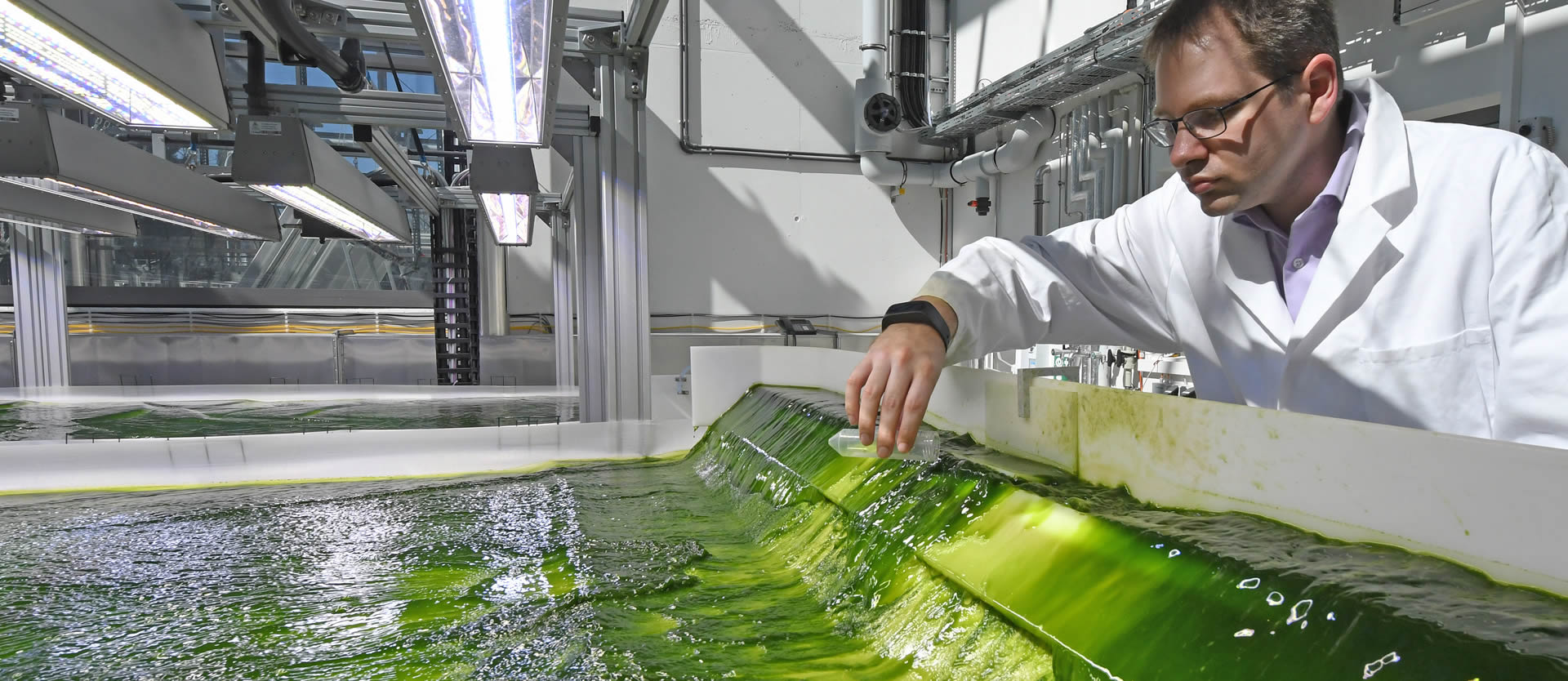Algae and the Future of Aviation

The air smells of sea-salt and the temperature is close to 30°C. But we’re not on the shores of the Mediterranean – we’re in the TUM-AlgaeTec Center. Situated on the Technical University of Munich’s Ludwig Bölkow Campus in Taufkirchen south of the Bavarian capital, the Center looks for all the world like a large greenhouse (and green is the operative word here, as we shall see!)
Dr. Daniel Garbe dips a small plastic tube into the green water that circulates between thin sheets of plastic film throughout the facility. The illumination is supplied by arrays of overhead LEDs. Garbe’s sampling tube is now full of an emerald-green liquid. The color results from the photosynthetic pigments present in the billions of microalgae suspended in the water.
Microalgae like these may well provide the basis for tomorrow’s propulsion systems. They produce energy-rich oils, which can in principle be substituted for fossil fuels. “It takes our algae two weeks to reach the cell density required to give this intensely green colour,” says Dr. Garbe. The cells are nearly ready to be harvested, and members of the TUM‘s Industrial Biocatalysis Group, together with their colleagues at the Chair of Bioprocess Engineering, will soon go about recovering the cells from the medium. Then specialists at the TUM’s Chair of Technical Chemistry II come into play, for it is their task to isolate and convert the algal oils into biofuels by means of a process that involves only a few steps. “The chemical composition of this algal biofuel is comparable to that of the kerosene that is now used to power commercial aircraft,” Garbe says – which explains why Airbus is interested in the technology, and why the Algaetec Center is located on the company’s premises. “We obtain approximately 500 grams of fuel per liter of algae. A barrel of aviation fuel currently costs in the region of 100 dollars, while the cost of algal biofuel is 2 to 3 times higher. “But we’re making good progress,” Garbe avers. For the TUM-AlgaeTec Center is a test-bed, designed to determine which of the many thousands of algal species are best suited for the production of biokerosene and to define the conditions under which they proliferate at the highest rate. “We are particularly interested in an Australian species, which grows rapidly and tolerates very high levels of salt, Garbe says.” So there is no need for genetic manipulation of the organisms? “We are confident that, over the course of billions of years, nature has done its very best to optimize the capabilities of algae,” Garbe replies.
© Airbus
The Munich researchers have obtained samples of algal species from all over the globe. After preliminary selection experiments in the laboratory, each of these is then tested at the TUM-AlgaeTec Center. The Center is equipped with lighting systems which enable the researchers to mimic the intensity and spectral quality of the sunlight to which the different algal species would be exposed in their natural habitats. Using combinations of LEDs with different emission spectra, they can generate light which is very similar to that of natural sunlight in the frequency band between 300 and 800 nanometers. In addition, in their laboratories on the Garching Research Campus, the researchers can also expose their microalgae to unnatural light spectra to test their response to novel lighting conditions.
It is estimated that there are on the order of 150,000 species of algae on our planet. Only about 5000 of these have been characterized – many of them quite superficially – and only a handful of them are currently in commercial use. The research staff at the TUM-AlgaeTecc Center hopes to change that in the not-too-distant future.
If worldwide efforts to produce biofuels in a cost-efficient manner in algal cultures were to be successful, the ecological repercussions could be substantial. It would mean, for instance, that air travel would become carbon neutral, since algae utilize atmospheric carbon dioxide – one of the major drivers of climate change – for the synthesis of oils and other metabolites. And while aviation fuel can also be produced from feedstocks grown on cropland, such as maize, the alga-based process is far more efficient. “While the production of biofuel on the basis of maize inevitably raises the problem of competition between fuel and foodstuff,” says Professor Thomas Bruck, who holds the Chair of Industrial Biocatalysis at the TUM, “marine algae can be grown in seawater, and require neither fertile cropland nor the use of pesticides for their cultivation. And yet they generate yields per hectare and year that are more than an order of magnitude higher than those attainable with maize.”
Meanwhile, Daniel Garbe has had time to analyze the cells in his sample under the microscope, and he is obviously very pleased with the result. “In terms of its growth rate, this species looks very promising. I’m anxious to know how much biofuel we can get out this little guy.”













